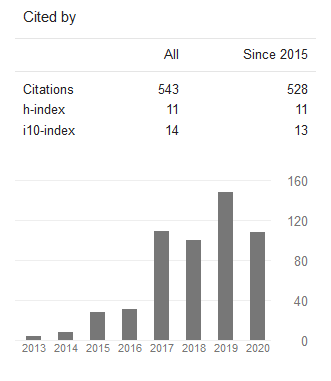Teknologi dan Teknik Sistem Komputasi Pervasif dalam Sistem Layanan Kesehatan: Studi Literatur Sistematis
DOI:
https://doi.org/10.24002/jbi.v7i3.657Abstract
Abstract. Technology of pervasive computing can be applied in daily activities such as sport, education, game and public interest such as public health. In healthcare system, the issues about high cost and errors in reviewing of patient record are still a major topic for healthcare provider (hospital). The technology of pervasive computing was developed to address these issues. This study will discuss the technology to support healthcare system. The main purpose is that users need to know the technology and its characteristics in order to prevent fatal actions in its use. The integration of different kinds of technology such as mobile devices, wireless networks, sensors, and wearable technologies is able to give better healthcare service than the technology itself.
Keywords: Technology, Pervasive Healthcare System, Systematic Literature Review.
Abstrak. Teknologi komputasi pervasif dapat diterapkan dalam aktifitas manusia mulai dari kebutuhan pribadi seperti olahraga, belajar, permainan dan kepentingan umum seperti kesehatan umum. Dalam sistem layanan kesehatan,isu tentang biaya yang tinggi, adanya kesalahan dalam review data pasien masih menjadi topik utama bagi penyedia layanan kesehatan (rumah sakit). Teknologi komputasi pervasif dikembangkan untuk mengatasi masalah tersebut. Dalam makalah ini akan dibahas mengenai teknologi dan karakteristiknya dalam mendukung sistem layanan kesehatan. Tujuan utama adalah pengguna harus mengetahui teknologi dan karakteristiknya agar tidak terjadi tindakan fatal dalam penggunaanya. Integrasi antar teknologi seperti mobile device, wireless network, sensor, dan wearable technologies mampu memberikan layanan kesehatan yang lebih baik dibanding teknologi itu sendiri.
Kata Kunci: Teknologi, Sistem Layanan Kesehatan Pervasif, Studi Literatur Sistematis.
References
. Alemdar, H. & Ersoy, C., 2010. Wireless sensor networks for healthcare: A survey. Computer Networks, 54(15), pp.2688–2710.
. Bardram, J. E., Frost, M., Szántó, K., Faurholt-Jepsen, M., Vinberg, M., & Kessing, L. V. 2013. Designing mobile health technology for bipolar disorder: a field trial of the monarca system. In Proceedings of the SIGCHI Conference on Human Factors in Computing Systems (pp. 2627-2636). ACM.
. Bayraktar, C., Karan, O. & Gümüşkaya, H., 2011. Diagnosing internal illnesses using pervasive healthcare computing and neural networks. Procedia Computer Science, 3, pp.584–588.
. Bromuri, S., Schumacher, M. I., Stathis, K., & Ruiz, J. 2011. Monitoring gestational diabetes mellitus with cognitive agents and agent environments. In Proceedings of the 2011 IEEE/WIC/ACM International Conferences on Web Intelligence and Intelligent Agent Technology-Volume 02(pp. 409-414). IEEE Computer Society.
. Chen, K. R., Lin, Y. L., & Huang, M. S. 2011. A mobile biomedical device by novel antenna technology for cloud computing resource toward pervasive healthcare. In Bioinformatics and Bioengineering (bibe), 2011 ieee 11th International Conference on (pp. 133-136). IEEE.
. Delmastro, F., 2012. Pervasive communications in healthcare. Computer Communications, 35(11), pp.1284–1295.
. Fogtmann, M., Grønbæk, K. & Ludvigsen, M., 2011. Interaction technology for collective and psychomotor training in sports. Proceedings of the 8th International Conference on Advances in Computer Entertainment Technology, pp.13:1–13:8.
. Germano, J., Ramalho, R. & Sousa, L., 2009. On the design of distributed autonomous embedded systems for biomedical applications. Proceedings of the 3d International ICST Conference on Pervasive Computing Technologies for Healthcare, pp.1-8.
. Ghose, A., Bhaumik, C., Das, D., & Agrawal, A. K. 2012. Mobile healthcare infrastructure for home and small clinic. In Proceedings of the 2nd ACM international workshop on Pervasive Wireless Healthcare (pp. 15-20). ACM.
. Gravenhorst, F., Muaremi, A., Bardram, J., Grünerbl, A., Mayora, O., Wurzer, G., & Tröster, G. 2015. Mobile phones as medical devices in mental disorder treatment: an overview. Personal and Ubiquitous Computing, 19(2), 335-353.
. Guo, S. H. M., Chang, H. K., & Lin, C. Y. 2015. Impact of Mobile Diabetes Self-Care System on patients’ knowledge, behavior and efficacy. Computers in Industry, 69, 22-29.
. Karan, O., Bayraktar, C., Gümüşkaya, H., & Karlık, B. (2012). Diagnosing diabetes using neural networks on small mobile devices. Expert Systems with Applications, 39(1), 54-60.
. Kim, S.C., Jeong, Y.S. & Park, S.O., 2013. RFID-based indoor location tracking to ensure the safety of the elderly in smart home environments. Personal and Ubiquitous Computing, 17(8), pp.1699–1707.
. Koufi, V., Malamateniou, F. & Vassilacopoulos, G., 2010. A system for the provision of medical diagnostic and treatment advice in home care environment. Personal and Ubiquitous Computing, 14(6), pp.551–561.
. Kulkarni, P. & Ozturk, Y., 2011. mPHASiS: Mobile patient healthcare and sensor information system. Journal of Network and Computer Applications, 34(1), pp.402–417.
. Laine, T. H., Vinni, M., Sedano, C. I., & Joy, M. 2010. On designing a pervasive mobile learning platform. Research in Learning Technology, 18(1), pp.3-17.
. Lee, C. N. 2012. A home care service platform for mobile healthcare. In2012 International Conference on Machine Learning and Cybernetics (Vol. 5, pp. 1927-1930). IEEE.
. Maitland, J., McGee-Lennon, M. & Mulvenna, M., 2011. Pervasive healthcare: from orange alerts to mindcare. ACM SIGHIT Record, 1(1), pp.38–40.
. Medjahed, H., Istrate, D., Boudy, J., & Dorizzi, B. 2009. Human activities of daily living recognition using fuzzy logic for elderly home monitoring. In Fuzzy Systems, 2009. FUZZ-IEEE 2009. IEEE International Conference on (pp. 2001-2006). IEEE.
. Moritz, G., Zeeb, E., Golatowski, F., Timmermann, D., & Stoll, R. (2009, April). Web services to improve interoperability of home healthcare devices. In 2009 3rd International Conference on Pervasive Computing Technologies for Healthcare (pp. 1-4). IEEE.
. Muras, J. A., Cahill, V., & Stokes, E. K. 2006. A taxonomy of pervasive healthcare systems. In 2006 Pervasive Health Conference and Workshops (pp. 1-10). IEEE.
. Niyato, D., Hossain, E. & Camorlinga, S., 2009. Remote patient monitoring service using heterogeneous wireless access networks: Architecture and optimization. IEEE Journal on Selected Areas in Communications, 27(4), pp.412–423.
. Pang, Z., Chen, Q. & Zheng, L., 2009. A pervasive and preventive healthcare solution for medication noncompliance and daily monitoring. 2nd International Symposium on Applied Sciences in Biomedical and Communication Technologies, pp.1–6.
. Postolache, O., Girão, P., Pinheiro, E., Madeira, R., Pereira, J. D., Mendes, J., & Moura, C. 2011. Multi-usage of microwave Doppler radar in pervasive healthcare systems for elderly. In Instrumentation and Measurement Technology Conference (I2MTC), pp. 1-5.
. Preuveneers, D. & Berbers, Y., 2008. Mobile phones assisting with health self-care: a diabetes case study. Proceedings of the 10th international conference on Human computer interaction with mobile devices and services, pp.177–186.
. Rabie, T. & Klopper, H.C., 2015. Guidelines to facilitate self-care among older persons in South Africa. Health SA Gesondheid, 20(1), pp.33–44.
. Salih, R.M., Othmane, L. Ben & Lilien, L., 2011. Privacy Protection in Pervasive Healthcare Monitoring Systems with Active Bundles. 2011 IEEE Ninth International Symposium on Parallel and Distributed Processing with Applications Workshops, pp.311–315.
. Srivastava, P.K., Srivastava, S., Singh, A.K., Dwivedi, K.N. 2015. Role of Ayurveda in Management of Diabetes Mellitus. International Research Journal of Pharmacy, 6(1), pp.8–9.
. Subhiyakto, E.R., Utomo, D.W. & Adi, P.W., 2015. Teknologi dan Teknik Sistem Terdistribusi Pervasif dalam Bidang Logistik : Studi Literatur Sistematis. Jurnal Buana Informatika, (2012), 7(2), pp.83–94.
. Torrado-Carvajal, A., Rodriguez-Sanchez, M. C., Rodriguez-Moreno, A., Borromeo, S., Garro-Gomez, C., Hernandez-Tamames, J. A., & Luaces, M. 2012. Changing communications within hospital and home health care. In 2012 Annual International Conference of the IEEE Engineering in Medicine and Biology Society (pp. 6074-6077). IEEE.
. Tu, Y. J., Zhou, W., & Piramuthu, S. 2009. Identifying RFID-embedded objects in pervasive healthcare applications. Decision Support Systems, 46(2), 586-593.
. van der Linden, J., Rogers, Y., Taylor, C., & Dalgleish, M. 2011. Technology inspired design for pervasive healthcare. In 2011 5th International Conference on Pervasive Computing Technologies for Healthcare (PervasiveHealth) and Workshops (pp. 609-613). IEEE.
. Venkatalakshmi, B., Renold, A. P., & Packiam, R. L. 2011. Smart RFID care [SRC] for pervasive health care system. In Communication Software and Networks (ICCSN), 2011 IEEE 3rd International Conference on (pp. 650-653). IEEE.
. Yuan, B. & Herbert, J., 2012. Fuzzy CARA - A Fuzzy-Based Context Reasoning System For Pervasive Healthcare. Procedia Computer Science, 10, pp.357–365.
. Yuan, B., & Herbert, J. 2011a. Non-intrusive movement detection in cara pervasive healthcare application. In The 2011 international conference on wireless networks, WORLDCOMP (Vol. 11, pp. 360-366).
. Yuan, B. & Herbert, J., 2011b. Web-based real-time remote monitoring for pervasive healthcare. 2011 IEEE International Conference on Pervasive Computing and Communications Workshops (PERCOM Workshops), pp.625–629.
. Ziefle, M., & Röcker, C. (2010). Acceptance of pervasive healthcare systems: A comparison of different implementation concepts. PervasiveHealth, 10, 1-6.
Downloads
Published
Issue
Section
License
Copyright of this journal is assigned to Jurnal Buana Informatika as the journal publisher by the knowledge of author, whilst the moral right of the publication belongs to author. Every printed and electronic publications are open access for educational purposes, research, and library. The editorial board is not responsible for copyright violation to the other than them aims mentioned before. The reproduction of any part of this journal (printed or online) will be allowed only with a written permission from Jurnal Buana Informatika.
This work is licensed under a Creative Commons Attribution-ShareAlike 4.0 International License.









